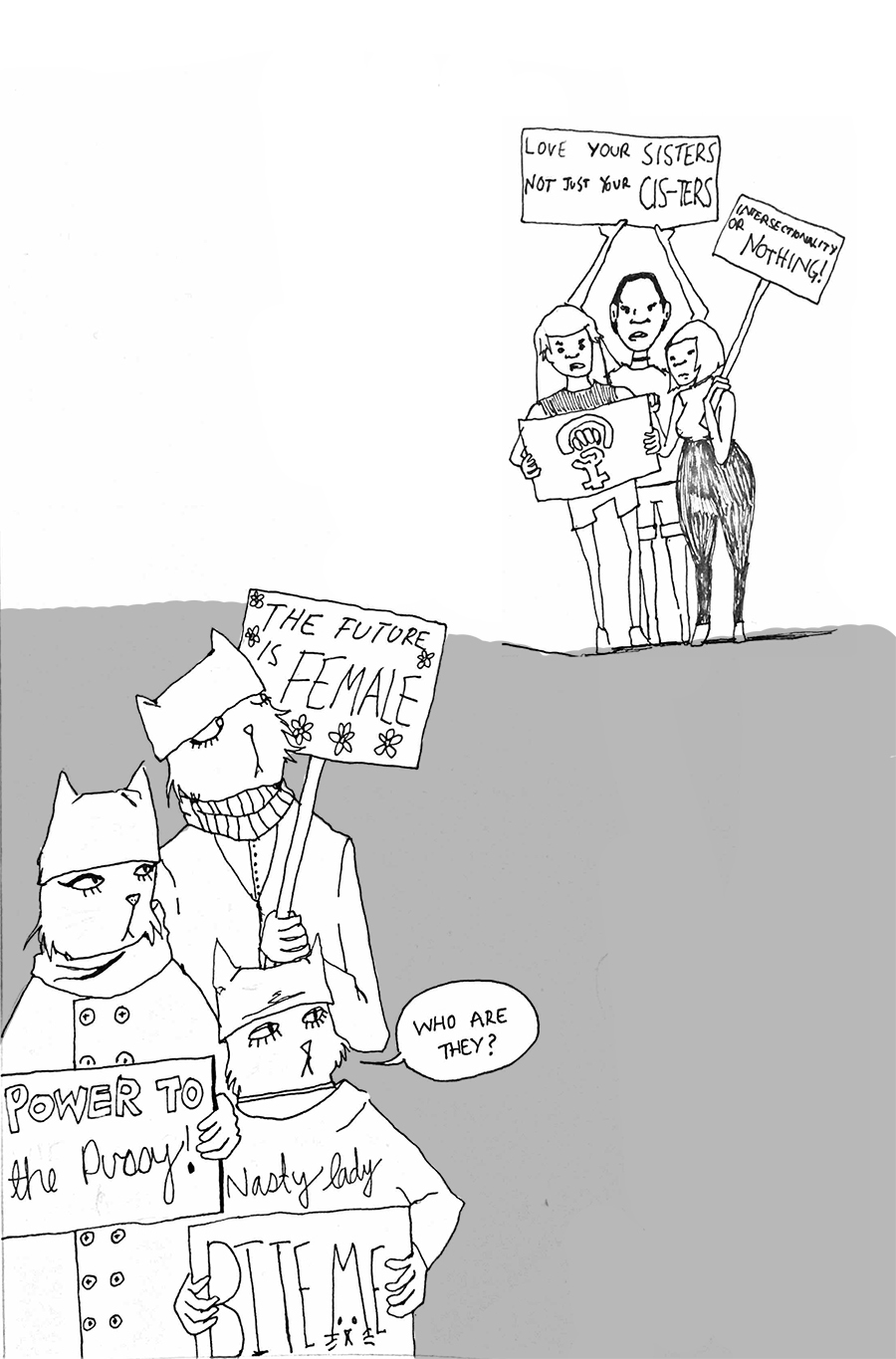Last Saturday, women and allies across the nation joined together for the Women’s March on Washington. The march was joined by solidarity demonstrations across the nation in protest of President Donald Trump’s inauguration and the sexist remarks made throughout his campaign of hate.
Shortly following election night, friends Krista Suh and Jayna Zweiman began an online campaign titled “The Pussyhat Project,” with their mission to make a powerful visual statement and provide a “framework for community and personal agency.” The hand-knitted pink cat-ear hats also provided an avenue to represent women who were not able to physically attend the march, according to the project’s website.
The major disconnect which I am concerned with is the project’s, as well as the Women’s March on Washington’s, lack of concern with transgender activism and solidarity. Current divisions among activist groups reflect a history of transgender activism; leaders of early civil rights movements like Marsha P. Johnson and Silvia Rivera are left forgotten despite their efforts to fight against exclusionary methods used by women’s rights activists at the time. Despite solidarity efforts by trans activists, mainstream feminism consistently falls short by failing to recognize that women’s rights are transwomen rights.
Current activism strives to maintain women’s rights and ensure that legislation and funding for women’s organizations are not revoked. A recent article by The Hill reports that Planned Parenthood officials are anticipating defunding by the GOP. Along with this threat, threats to health care, and Trump’s consistently sexist and discriminatory remarks, frustrations among the general population persist. People were in high attendance at solidarity marches in various major cities over the weekend — with the main March on Washington having an incredible turnout of about 400,000, according to The New York Times.
The sheer number of participants and level of organization which has taken place this weekend is evidence that American society is far from equal. Pussyhat does provide a creative and do-it-yourself outlet to express solidarity for women’s rights, feminism and equality — subjects which the Pussyhat Project’s blog regards as human rights issues. This is denoted by the popular slogan, “Women’s rights are human rights,” which participants have adopted for their posters.
Human rights are indisputable; h. However, when women’s rights are categorized under such sweeping generalizations, important systemic problems are swept under the rug. For when we delve into the specifics, we truly understand how a neoliberal nation such as the United States continues to benefit from systematic discrimination of women, leaving queer women, women of color and queer women of color at the very bottom of the list of vulnerable members of society.
It is our responsibility as activists, allies and marginalized peoples to thoroughly and critically question The Pussyhat Project — the language employed by their founders, their chosen symbol of pink cat ears, and the very act of hand-knitted projects within the greater context of assigned gender identities and roles in American society.
DIY approaches to basic amenities, such as clothing garments are great solutions to promote sustainable living and local economies, but how productive are these efforts within limited ideas of gender? The Pussyhat Project’s online blog offers plenty of creative and Pinterest-esque directions for organizing and continuing communication between the creator of the hat and the marcher or “wearer.” The website provides links to register your knitted beanie so that a more accurate count of garments may be recorded, as well as well-intentioned directions for what to do with the hats after the March on Washington — which include recommendations to donate your hat to shelters or fellow feminists.
A discussion on the color of the hat is necessary, if anything useful to understand discussions surrounding women’s rights and efforts in the context of societal expectations and gendered roles. Modern feminists who are adamant about the inclusivity and empowerment of femininity in the movement use “traditional” markers of such femininity (i.e., the color pink, cats or “pussies” becoming a feminist symbol for vagina, focus on the uterus, etc) ironically, so that they may reclaim these gender assignments in a way that is seen as radical and empowering.
We are constantly reminded of the importance of “pink:” the prominence of rape culture, workplace discrimination against women, legislation which denies women access to birth control — the list goes on and on. Social media has greatly impacted efforts to educate and inform people on cases of violence against transwomen (especially transwomen of color); despite this, we still see a lack of representation and concern for transwomen. Organizations like The Pussyhat Project continue to perpetuate transphobic language, while performing within traditional gender norms which produce equally detrimental outcomes. And while femininity as a lifestyle is a choice, the “empowerment” it garners is one which remains respectable and gendered. Such “empowerment” appeals to masses who understand only pink and blue; “empowerment” within the same rigid system which transwomen must exist and survive in — and are also killed and discriminated against because of systemic misogyny.
“Pussyhat’s” double entendre continues to add insult to injury, as it continues to use essentialist language which equates women to their assigned genitalia. The reappropriation of the term “pussy” hardly makes any radical leaps with the inclusion of a ferocious cat image — as it is another reminder of the way feminized images and symbols continue to be gendered. The image of the hissing pink pussy along with such phrases as “Pussy bites back,” and “My pussy, my rules,” continue to link gender to genitalia, which is not productive allyship.
The March on Washington and solidarity marches across the nation point to the rifts between women and allies on deeply complex levels. If the Pussyhat evokes the presence of women who are not physically able take to the streets, I can only imagine how many transwomen, transwomen of color and women and people who do not identify within the gender binary are left unrepresented and forgotten. If the Pussyhat represents feminists, what does it do for intersectional feminists? A pink hat is not a solid step forward for those activists and allies who are most concerned with the disestablishment of respectable forms of activism so that true solidarity is felt for those most vulnerable members of society.




